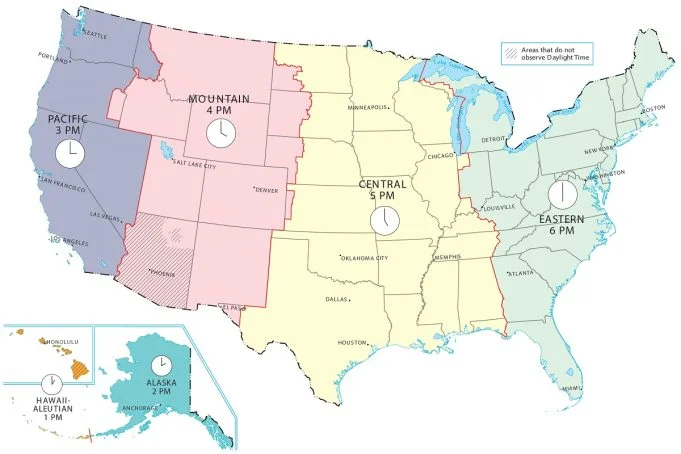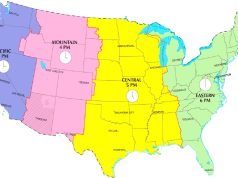The Central Time Zone observes standard time in North America by subtracting six hours from UTC during standard time (UTC06) and five hours during daylight saving time (UTC05). This time zone, which consists almost entirely of a narrow swath of North American territory, is based on the mean solar time of the 90th meridian west of the Greenwich Observatory.
This time zone is known as Central Time (CT) in the United States and Canada, but in Mexico, it is known as Tiempo del Centro. In particular, it is Central Standard Time (CST) when standard time is observed (winter) and Central Daylight Time (CDT) when daylight saving time is observed (summer). In Mexico, regardless of time zone, daylight saving time is known as Horario de Verano (“Summer Time”).
It is two hours ahead of Pacific Time, one hour ahead of Mountain Time, and one hour behind Eastern Time.
What is Time Zone?
A time zone is a region where a uniform standard time applies for legal, economic, and social reasons. The width of standard time zones is 15 degrees of longitude.
A time zone is ideally one of 24 spherical lunes (a section on the globe in a north/south direction) with equal width (15 degrees), each assigned one of the 24 hours (makes up one day and one rotation of the Earth). Typically, each section maintains a uniform standard time to monitor the day and night cycle. This indicates that all geographic regions within a given time zone observe the same time.
All of these time zones are defined by a number of hours offset from Coordinated Universal Time (UTC; see below), centered on the prime meridian (0°; since 1884, the Greenwich meridian). Today, time zones tend to follow the boundaries of countries and their subdivisions rather than the standard parallels, as it is more convenient to maintain the same time in close economic or political areas.
The majority of Alaska, for instance, employs Alaska Time, which spans three standard time zones. The state utilized two time zones until 1983, when the capital, Juneau, was positioned in the same time zone as Anchorage and Fairbanks. China spans four time zones, but it only observes one. Despite sharing nearly the same longitude, Bangkok, Thailand, and Kuala Lumpur, Malaysia are separated by one hour in terms of time.
How Does CDT Work?
Even when people comprehend the importance of using CDT, it can be difficult for them to adapt to its mechanism and determine how it operates. The only obvious fact is that we adjust our clocks in the spring to gain an hour of daylight in the summer. But specifically, when do people change their clocks from 2:00 to 3:00?
In fact, the majority of the United States transitions to central daylight time on the second Sunday of March at 2:00 a.m. On the first Sunday of November, the clocks are adjusted back to standard time. Since various states in the United States use different time zones, it goes without saying that each time zone changes in the United States at a different time.
Therefore, in the European Union, countries that recognize CDT switch to central daylight time on the last Sunday of March and return to Universal Time (or Greenwich Mean Time) on the last Sunday of October. In contrast to the Americas, all time zones alter simultaneously in the EU.
About Central Time Zone
A time zone is a geographic area’s standard time. It’s the time we’ve all agreed to adhere to, making it easier to travel, communicate, and transact with people all over the globe. Many of these boundaries are negotiated and agreed upon based on each country’s requirements.
The Central Time Zone (CT) includes the following locations:
- Central Standard Time (CST)
- Central Daylight Time (CDT)
Depending on whether the region using the zone observes daylight savings time during the spring and summer months, Central time zones can be either Standard or Daylight. CST, also known as Central Standard Time, is six hours behind Coordinated Universal Time (UTC -6:00).
During daylight savings time, the Central time zone transitions to Central Daylight Time (CDT), which is 5 hours behind Universal Time (UTC -05:00). This indicates that the time zones utilized in central time zone regions are seven positions behind Greenwich Mean Time.
Country | USA |
Time zone abbreviation | CST |
| Time zone name | Central Time |
| Time Offset | UTC/GMT-05:00 |
Observe DST | Yes |
Time Zone Difference
Central Time to Eastern Time | 1 hour behind Eastern Time |
Central Time to Mountain Time | 1 hour ahead of Mountain Time |
| Central Time to Pacific Time | 2 hours ahead of Pacific Time |
Time Zone Differences: Central vs. Eastern, Mountain, and Pacific
Eastern Time Zone
The Eastern Time Zone is a time zone that subtracts five hours from Coordinated Universal Time (UTC) or Greenwich Mean Time (GMT) to determine its standard time. Panama is the only nation in Central America to observe Eastern Standard Time.
Central American nations do not observe Daylight Saving Time and observe Standard Time year-round.
Mountain Time Zone
In the northern portion of the country, Mountain Time Zone is observed. The time in this time zone is calculated by subtracting seven hours from Greenwich Mean Time or GMT (UTC-7) to arrive at the local time. This time zone is observed in the United States and Canada as Mountain Time or MT.
This time zone observes Mountain Standard Time (UTC-7) in the winter and Mountain Daylight Time (UTC-6) in the summer. Most states within this time zone observe this time alone, although some states, such as South Dakota, have areas that lie within the Mountain Time Zone and the Central Time Zone.
Pacific Time Zone
Despite the fact that the Pacific time zone is only used in specific regions of three countries, it is well-known throughout the globe due to the numerous metropolitan areas on the American west coast. It stretches from Vancouver, Canada, to Seattle, San Francisco, Los Angeles, San Diego, and Baja California, Mexico, along the Pacific coast.
Pacific Standard Time (PST) is three hours behind Atlantic Standard Time, nine hours behind Central European Standard Time, and eighteen hours behind Sydney.
In the summer, all three zones transition simultaneously to Pacific Daylight Time.
Interesting Facts About Time Zones
- Central Daylight Time is Daylight-Saving Time, as its name suggests. Central Standard Time, alternatively, is not. Therefore, while CDT is UTC-05:00, CST is only UTC-6:00. Remember this when scheduling a call with someone in Texas or Alabama, particularly if your country does not observe Daylight Savings Time.
Saskatchewan, in Canada, does not observe daylight saving time. In other terms, this territory is permanently subject to daylight saving time. - The transition to CDT occurs at 2:00 a.m. on the second Sunday of March. The return to CST occurs at 2:00 AM on the first Sunday of November.
There are time zones whose offsets consist of fractions of an hour. Indian time, for example, is UTC+05:30. It is also fascinating to note that India’s vast territory utilizes a standardized hour. Thus, the local time is the same everywhere in India. Nepal’s UTC offset also utilizes fractions of an hour; Nepal’s time is UTC+05:45. - Not all territories add one hour to their clocks during the transition to Daylight Saving Time. Lord Howe Island in Australia advances the lock by only 30 minutes instead of the standard hour.
- Putin eliminated three of Russia’s twelve time zones. Currently, Russia has only nine time zones, although it spans no less than twelve.
- China has only a one-time zone (UTC+08:00), which makes this time zone extremely large. In fact, it is the largest time zone on the planet, but it is a convention rather than a geographical fact.
- Greenwich Mean Time (GMT) and London Time are identical only during the winter. The United Kingdom observes Summer Time (GMT+01:00) in the summer. Moreover, the British invented GMT.
Frequently Asked Questions (FAQs)
Which country is central time?
The second-most eastern time zone in the United States, Central Standard Time (CST) is also used in Canada. It encompasses twenty states in the United States and three provinces or territories in Canada. Additionally, it is used in Mexico and Central America.
Where is US Central Time Zone?
About one-third of the United States’ population resides in the CST time zone. It stretches all the way from northern Canada to Costa Rica near the equator. In North America, Central Standard Time shares a border with Eastern Standard Time (EST) and Mountain Standard Time (MST) in the east and west, respectively.
What is Central Time Zone GMT?
The Central Time Zone is a region that is six hours behind Greenwich Mean Time (GMT-6) in the winter (referred to as CST) and five hours behind Greenwich Mean Time (GMT-5) in the summer (referred to as CDT).
What is the biggest city in the US Central Time Zone?
This time zone is one hour ahead of Mountain Standard Time and one hour behind Eastern Standard Time. Mexico metropolis is the largest metropolis in the Central Time Zone. Chicago is the largest metropolis in the United States, and the Chicago metropolitan area is the largest metropolitan area.
Who is in Central Standard Time?
The North American Central Time Zone (CT or C) encompasses portions of Canada, the United States, Mexico, Central America, certain Caribbean territories, and a portion of the Eastern Pacific Ocean. A portion of this time zone observes DST. Coordinated Universal Time (UTC) is six hours ahead of Central Standard Time (CST).
Is Chicago time Central?
Not only is Illinois located in the Central Time Zone, but Chicago is the largest city in the entire Central Time Zone! During Daylight Standard Time, Chicago is six hours behind Greenwich’s Mean Time (November through April).
Is it New York Central time?
New York is located in the Eastern Time Zone (UTC-05:00) and observes daylight saving time (UTC-04:00).
Is Texas Central time?
El Paso and Hudspeth, two municipalities in the southwest corner of the state, are the only ones to observe Mountain Time.
How many time zones are there in the USA?
The 50 states of the United States span eight standard time zones, ranging from UTC (GMT) 4 to 11 hours. There are six designated US time zones and four within the contiguous United States.













![25 Best Peruvian Foods You Must Try In Peru [With Recipes] Peruvian Food](https://tourinplanet.com/wp-content/uploads/2024/07/Peruvian-Food-100x75.jpg)












![What is The Marvelous VFR C500? – [Key Features and Overview] Marvelous VFR c500](https://tourinplanet.com/wp-content/uploads/2024/07/Marvelous-VFR-c500-100x75.jpg)

